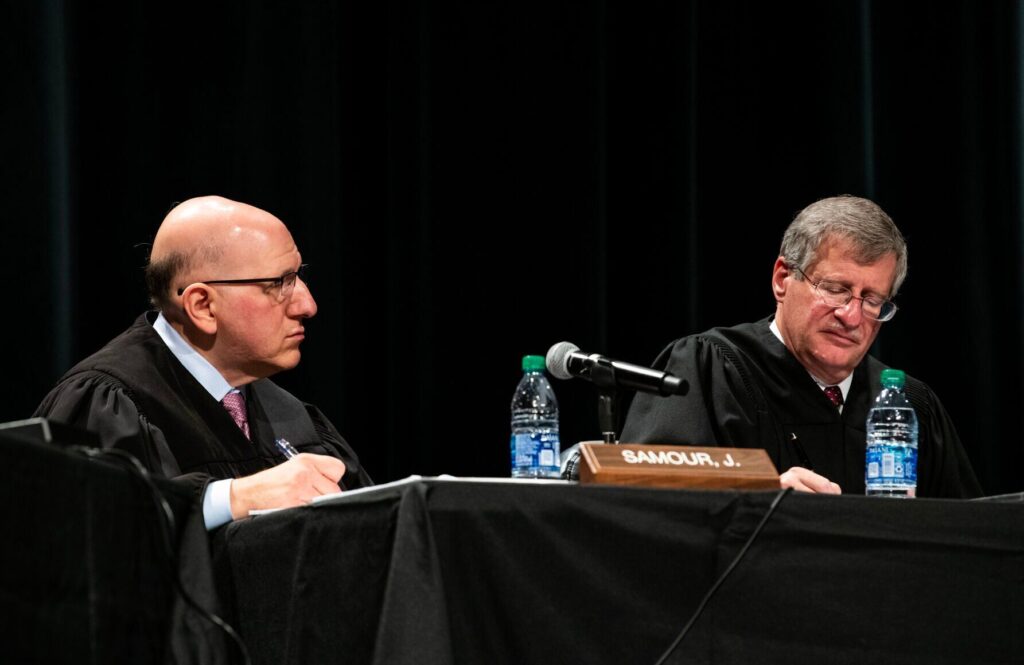Martin Drake Power Plant demolition underway, study of ‘once-in-a-century opportunity’ takes shape

In the coming weeks – slowly, deliberately, piece by piece – the dominant smokestacks of the now-closed Martin Drake Power Plant that pepper the skyline of Colorado Springs’ downtown will be no more.
Demolition efforts at one of the last remaining urban power plants in the country began in May, with crews conducting asbestos abatement work inside and outside the old structures, Colorado Springs Utilities spokesman Steve Berry said this week.
Officials expect to begin taking down the large smokestacks in the next couple of weeks and that work will continue for several weeks after, Berry said. The process is slow and deliberate so crews can do asbestos abatement while the stacks are still upright and again once the pieces are on the ground.
Colorado Springs Utilities details year-plus plan for demolishing Martin Drake Power Plant
“People will see the cranes pulling down exterior facades and other pieces from the structures, but to mitigate noise and dust they won’t see major structures coming down all at once. The safety of workers and the surrounding community is our first priority, as well as dust and noise control,” Berry said.
It’ll take until the end of 2024 for crews with Independence Demolition, an Ohio-based company with a Denver office, to demolish the aging 100-year-old plant over eight phases.

Crews are focusing on taking down the plant’s main structures, moving from north to south across the site, Berry said. They’ll first take down the baghouses, or filters used to control air pollution, and the scrubber buildings once used to clean gases passing through the coal-burning smokestacks, then the smokestacks and cooling tower building.
Grading and seeding the land sometime around the fall of 2024 marks the decommissioning project’s final phase.
The order of demolition could shift depending on abatement requirements, for example, but in general the work will happen from the outer edges of the site inward, Berry said.
Not all of the work will be visible from the outside, as crews disconnect and remove cable wires and pipe in the structures’ control panels to safely remove them from the site.
Natural gas units going up at Drake Power Plant, deconstruction of building likely years out
Utilities’ operations likely won’t be completely removed from the location until around 2030, including the electric substation just south of the old Drake structures and relocating six new modular natural gas generating units that now stand where coal once piled up near the plant.
As for remediation, the city-owned utility will take the site to “brownfield” status at the end of demolition efforts, Berry said.
“This means some abandoned materials may still be on site, but will be underneath several layers of backfill and natural vegetation to control dust,” he said.
The state requires environmental studies to then be conducted at the location, the results of which will dictate the land’s future use.
What’s next?
The Colorado Springs City Council, whose members also make up the Colorado Springs Utilities Board of Directors, will then work with residents to decide what to do with the site.
“Drake is really a once-in-a-century opportunity to understand that site and what its future potential could be,” said Susan Edmondson, president and CEO of the Downtown Partnership of Colorado Springs.
To help inform those future discussions, the Downtown Partnership and the Legacy Institute partnered independently of Colorado Springs Utilities to complete a 107-page visioning document laying out an expansive list of possible future options for the site, from housing to dog parks or even a solar farm.
The report “really is a framework of values and principles. This is not a report that is telling anyone, ‘Build X amount of square feet of this,'” Edmondson said.
Its authors used feedback gathered from residents at several listening sessions and community meetings held over 2½ years, starting in late 2019, to create a list of guiding principals and possible land uses, said Pam Shockley-Zalabak, the former University of Colorado Colorado Springs chancellor who led the process.
She asked residents to give their feedback and ideas free from possible financial, political or environmental constraints, a process called “conceptual blockbusting,” she said.
Colorado Springs takes major step toward cleaner energy with Martin Drake project
“We told them we know this is not necessarily realistic, but we want the biggest possible vision for the site, and what would (residents) value the most?”
The Downtown Partnership and Legacy Institute began the process by studying other communities in the U.S. and other parts of the world that successfully decommissioned coal plants, Shockley-Zalabak said. They studied their processes, experiences and funding sources.
“We also looked at it from an environmental cleanup perspective and asked what were the best uses, as a community, that they made of that?” she said.
Six case studies included in the report, completed between September and December 2020, analyzed the timeline of deconstruction, community engagement, renovation plans, construction and architectural partners on those decommissioning projects, among other factors, for various urban power plants and transportation hubs including the Battersea Power Station in London, the Denver Union Station in Denver and the Brayton Coal Power Plant in Somerset, Mass., as well as others.
The report found London’s historic Battersea Power Station, for example, is being renovated as a mixed-use neighborhood with restaurants, shops, parks and cultural spaces.
The Brayton Coal Power Plant in Massachusetts is now known as the Brayton Point Commerce Center, the report states, being redeveloped into “a hub for the offshore wind industry, … an area where offshore wind turbines can be assembled before they are shipped out to sea.”
And Denver’s Union Station redevelopment project turned 42 acres of former railyards on the historic Union Station into a mixed-use development around a hub for multimodal transportation.
Housing could be an unlikely option for the Drake site, Berry said.
“Based on our knowledge of required mitigation of former power plant sites around the U.S., things like residential housing (and) apartment units are unlikely due to extensive mitigation costs that would be borne by the buyer or developer,” he said.
As for other possible land uses on the land, the environmental reviews will inform those decisions.
“The environmental reviews will start and that will probably take some time. … But that’ll probably dictate what kind of options City Council has to take to the public,” Berry said.
The Downtown Partnership and Legacy Institute wanted to start the public input process early to guide decision-makers before “complex problems presented themselves and became more polarized,” Shockley-Zalabak said.
Many possible funding opportunities the city could opt into also require a robust public input process, which the report helps establish, Edmondson and Shockley-Zalabak said.
“This is vitally important,” Edmondson said of the planning process. “There is no other site right at our urban center, at the confluence of two waterways, at the confluence of an interstate and a highway. You’ve got to be really thoughtful about what that means.”
The full report is linked on the Utilities website at csu.org/Pages/MartinDrakePowerPlant.aspx, under the heading titled “The future of the site.”
The full Martin Drake report is linked on the Colorado Springs Utilities website at csu.org/Pages/MartinDrakePowerPlant.aspx, under the heading “The future of the site.”














